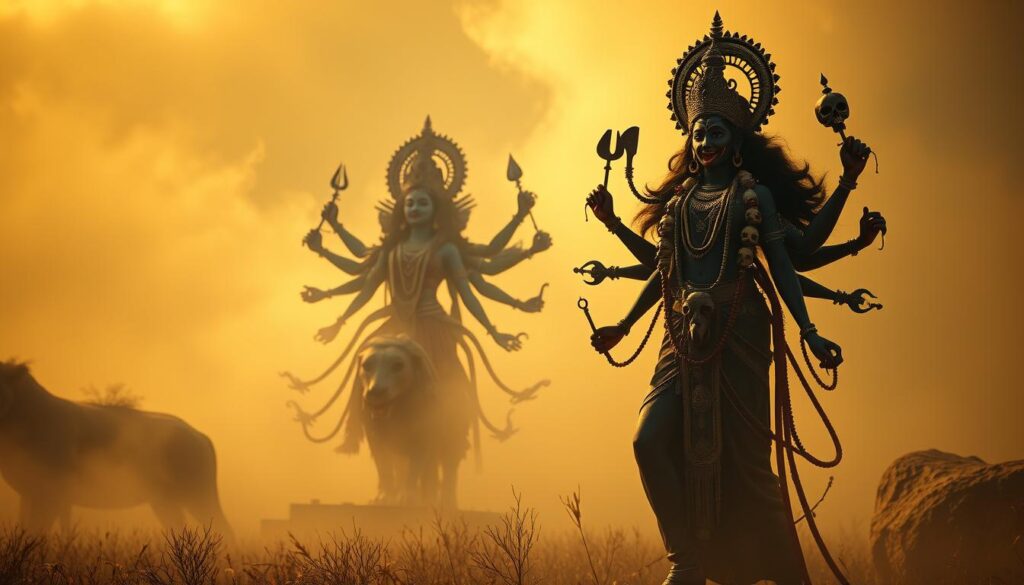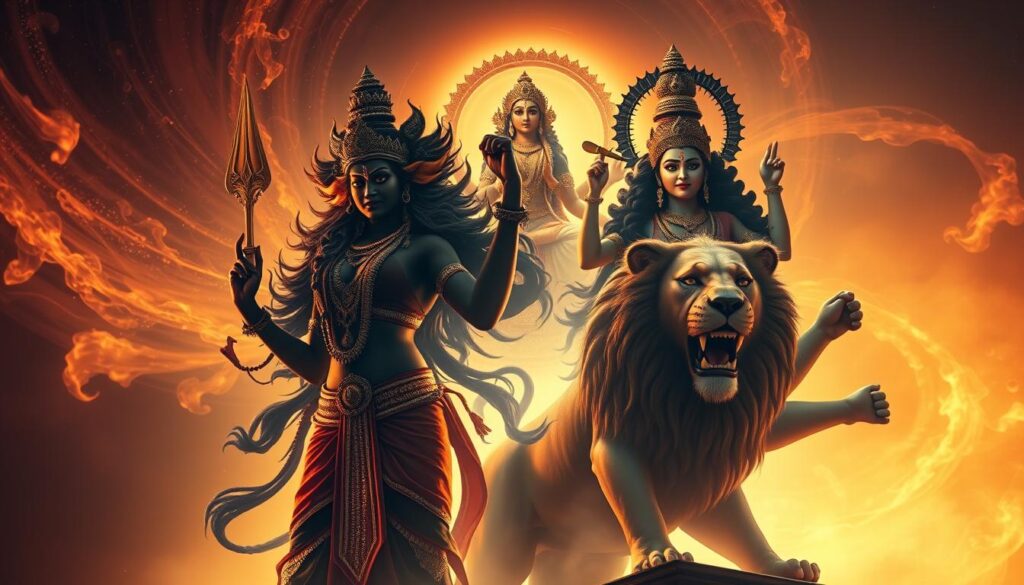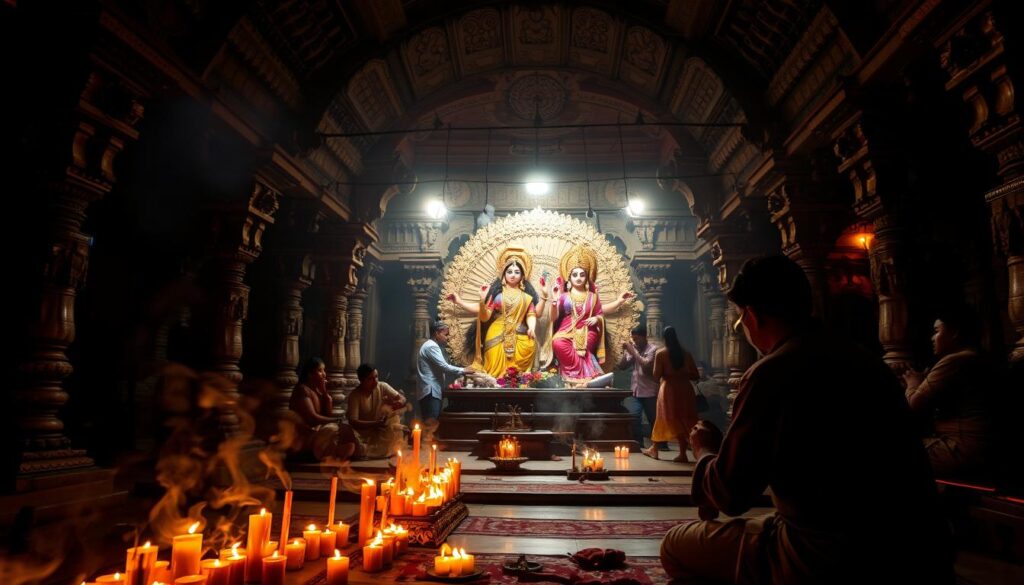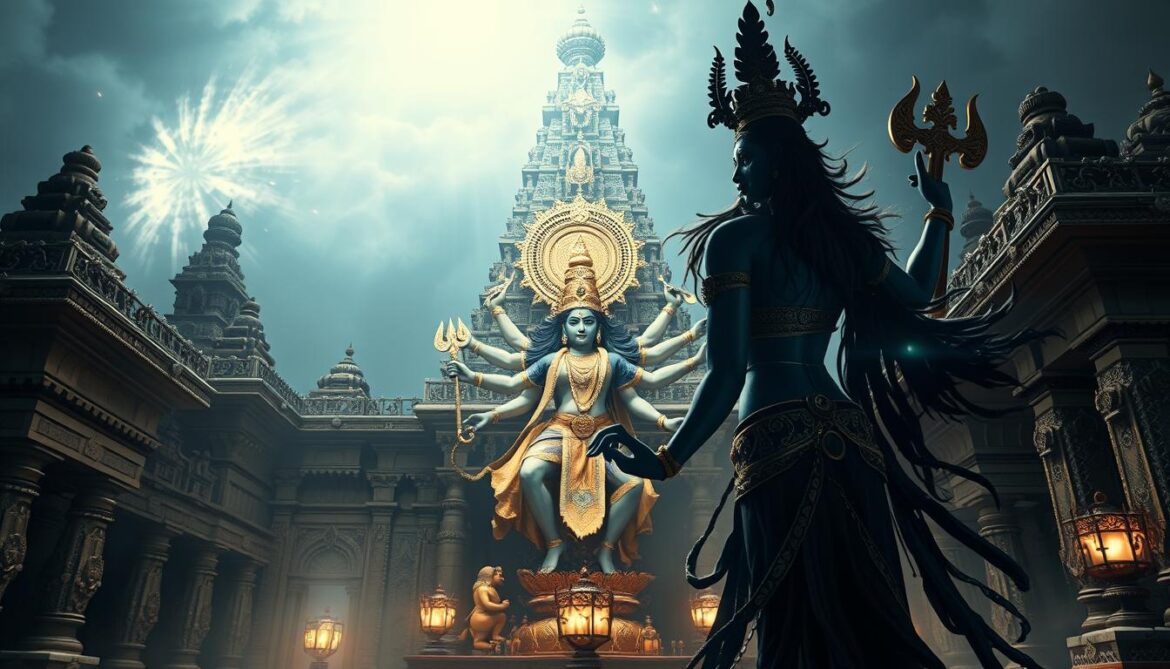Hindu mythology celebrates powerful female deities who embody strength, wisdom, and divine energy. Among them, two figures stand out for their contrasting yet equally revered roles—the fierce warrior and the protective mother. Their stories inspire millions, especially women, challenging traditional norms with their unshakable power.
These goddesses share deep connections with Lord Shiva and hold immense cultural significance in India. One represents destruction, while the other symbolizes preservation. Both, however, reflect the dynamic spectrum of feminine energy in spirituality and daily life.
This article explores their mythological origins, distinct iconography, and modern relevance. By understanding their differences, readers gain insight into how these deities shape faith, empowerment, and gender perspectives today.
Introduction to Kali and Durga
The spiritual landscape of Hinduism reveals two iconic figures representing contrasting yet complementary forces. One thrives in chaos, the other in cosmic order—yet both are revered as manifestations of divine feminine energy. Their stories challenge stereotypes, offering profound lessons on power and grace.
Who Is Goddess Kali?
Often depicted in cremation grounds, this deity embodies time, destruction, and rebirth. Her wild form—tongue outstretched, garlanded with skulls—symbolizes the raw force that dissolves illusions. Followers honor her through tantric rituals, embracing her power to shatter ego and fear.
Despite her fierce imagery, she protects devotees from evil. Her narrative defies traditional roles for women, showcasing strength beyond domesticity. She is both feared and loved, a paradox central to her worship.
Who Is Goddess Durga?
Born from collective divine energy, she rides a lion into battle against demons. Her eight arms wield weapons gifted by gods, reflecting her role as cosmic protector. Unlike her counterpart, she radiates serene authority, balancing fury with maternal warmth.
Mainstream festivals like Navratri celebrate her victory over evil. She represents disciplined power, inspiring women to embrace resilience. Together, these goddesses exemplify Shakti—the dynamic essence of creation and transformation.
Kali vs Durga: Origins and Mythological Stories

Ancient scriptures reveal how divine feminine energy manifests in contrasting yet powerful forms. Their legends, etched in sacred texts, unfold through epic battles and symbolic births. These narratives not only define their roles but also reflect deeper philosophical truths.
Kali’s Emergence in Hindu Texts
She first appeared in the Devi Mahatmya (6th century CE), born from Durga’s forehead during a fierce fight. The demon Raktabija, whose blood spawned clones, forced Durga to summon her. With her dark form and wild energy, she devoured the clones, ending the threat.
The Devi Bhagavata Purana describes her skin blackened from battle rage. Unlike Durga’s measured warfare, she thrives in chaos, symbolizing time’s relentless destruction. Yet, her violence serves a higher purpose—restoring balance.
Durga’s Role in Cosmic Battles
Created by the combined energies of Brahma, Vishnu, and Shiva, she embodies strategic power. Her mission: defeat Mahishasura, the shape-shifting buffalo demon. Riding a lion and wielding divine weapons, she represents order’s triumph over chaos.
Puranas recount her recurring battles, each highlighting her adaptability. While Kali dissolves illusions, Durga preserves harmony, proving their roles are intertwined. Together, they showcase the spectrum of Shakti—destruction and protection as one.
Appearance and Iconography
![]()
Visual symbolism in Hinduism captures divine energy through striking contrasts. The goddesses’ forms—wild and serene—mirror their cosmic roles. Art immortalizes their power, from ancient carvings to vibrant festival posters.
Kali’s Frightening yet Protective Form
Her blue-black skin symbolizes infinite darkness and timeless wisdom. A necklace of severed heads represents ego’s conquest, while her sword severs ignorance. Disheveled hair echoes untamed primal energy.
Kali’s nakedness transcends societal norms for women, embodying raw truth. Despite her fearsome look, she shields devotees, proving destruction nurtures renewal.
Durga’s Radiant Warrior Goddess Depiction
Golden-skinned and draped in red, she embodies victory and vitality. Eight arms wield divine weapons—each gifted by gods like Vishnu and Shiva. Her lion vahana signifies mastered primal instincts.
Durga’s calm expression balances ferocity with maternal grace. Unlike Kali’s chaos, her iconography reflects strategic power, inspiring devotion across generations.
Roles in Hindu Cosmology

In Hindu cosmology, divine forces manifest through cycles of creation and dissolution. These goddesses embody opposing yet interdependent energies, maintaining universal equilibrium. Their roles reflect deep philosophical truths about life, death, and renewal.
The Destroyer of Balance
One goddess thrives in chaos, her domain often linked to cremation grounds. She dismantles illusions, freeing souls from cyclical suffering. Marginalized communities revere her, seeing her as a liberator from societal constraints.
Her dark form symbolizes time’s inevitability, where all things must end. Yet, this destruction paves the way for rebirth. Sacred texts depict her dancing on Shiva, representing the transcendence of ego.
The Preserver of Cosmic Order
Her counterpart emerges as a strategist, wielding weapons gifted by gods. Household altars and community pandals honor her during festivals like Navratri. She shields devotees, embodying disciplined strength.
Unlike the wild energy of her counterpart, she stabilizes the universe. Seasonal celebrations mark her victories, reinforcing her role as a preservation force. Together, they exemplify the duality of divine power.
Regional practices across India’s sacred places highlight their contrasting worship styles. From tantric rituals to devotional hymns, these traditions reveal the goddesses’ multifaceted influence on spiritual and cultural life.
Association with Shiva

Shiva, the cosmic dancer, shares profound connections with two divine feminine energies. One ignites his destructive power, while the other grounds it in harmony. Together, they reflect the eternal dance of creation and dissolution.
The Energizer of Destruction
Kali’s wild tandava dance atop Shiva’s inert body symbolizes raw, untamed energy. Tantric texts describe her as the spark that activates his destructive force. Her dark form contrasts sharply with his pale asceticism, embodying dynamic tension.
In art, she often stands on Shiva’s chest, representing the transcendence of ego. This imagery teaches devotees about the cyclical nature of time—destruction precedes renewal.
The Stabilizer of Divine Power
As Parvati, Durga completes Shiva’s asceticism with householder energy. She tempers his detachment, bringing warmth and order to their union. Festivals depict her as a nurturing wife, balancing his meditative solitude.
Her role in Shaivism highlights preservation. While Kali thrives in chaos, Durga ensures Shiva’s power remains constructive. Together, they maintain cosmic balance.
- Iconography: Kali’s fierce stance vs. Durga’s serene companionship with Shiva.
- Tantric duality: Kali represents unrestrained energy; Durga channels it into stability.
- Cultural rituals: Blood sacrifices honor Kali, while devotional hymns celebrate Durga’s domestic harmony.
Cultural Significance and Worship

Across India, vibrant festivals and sacred rituals bring these goddesses to life in unique ways. From whispered tantric chants to grand processions, their worship blends ancient traditions with modern reinterpretations.
Tantric Roots and Evolving Sacrifices
In Bengal’s cremation grounds, devotees honor the dark goddess with offerings of red hibiscus and animal sacrifices. Tantric priests chant mantras to channel her fierce energy. These rituals symbolize the destruction of ego, not literal violence.
Urban temples now replace blood with symbolic red kumkum or pumpkins. This shift reflects contemporary values while preserving spiritual intent. The Kalighat Temple remains a key place for such transformative worship.
Festivals of Strength and Community
Durga Puja transforms cities into hubs of creativity. Temporary pandals house handcrafted idols, showcasing intricate artistry. Women lead ceremonies, from sculpting clay idols to performing sacred dances.
The festival’s 10-day climax, Visarjan, sees idols immersed in rivers—a metaphor for cyclical renewal. Economically, it boosts local craftsmen and tourism, proving faith and culture drive progress.
Reflecting on the Duality of Divine Feminine Power
The goddesses redefine womanhood in Hinduism, blending destruction and protection into one sacred force. One embodies chaos, the other order—yet both empower devotees to embrace life’s dualities. Their stories challenge rigid gender norms, offering a blueprint for spiritual and personal growth.
Modern feminist movements in India draw inspiration from their contrasting energies. Artists reinterpret their iconography, merging tradition with contemporary themes. This cultural evolution highlights their timeless relevance.
Balancing fierce independence with compassionate strength, these deities teach a vital lesson. True power lies in harmonizing opposing forces—within faith and oneself.

